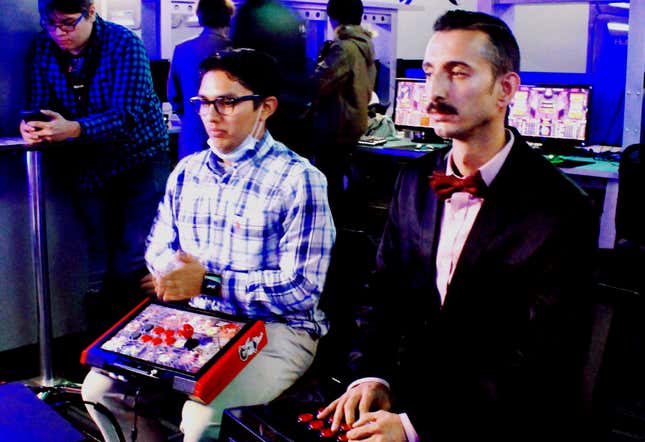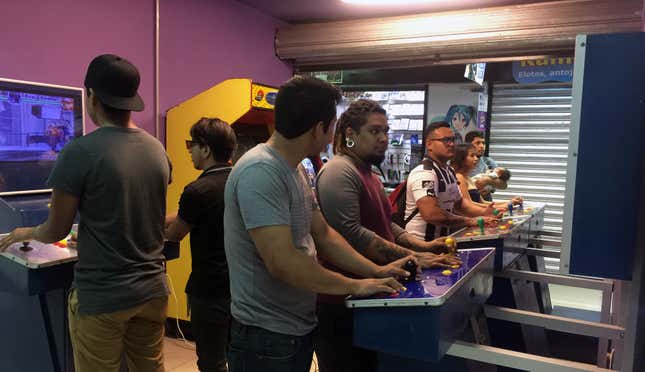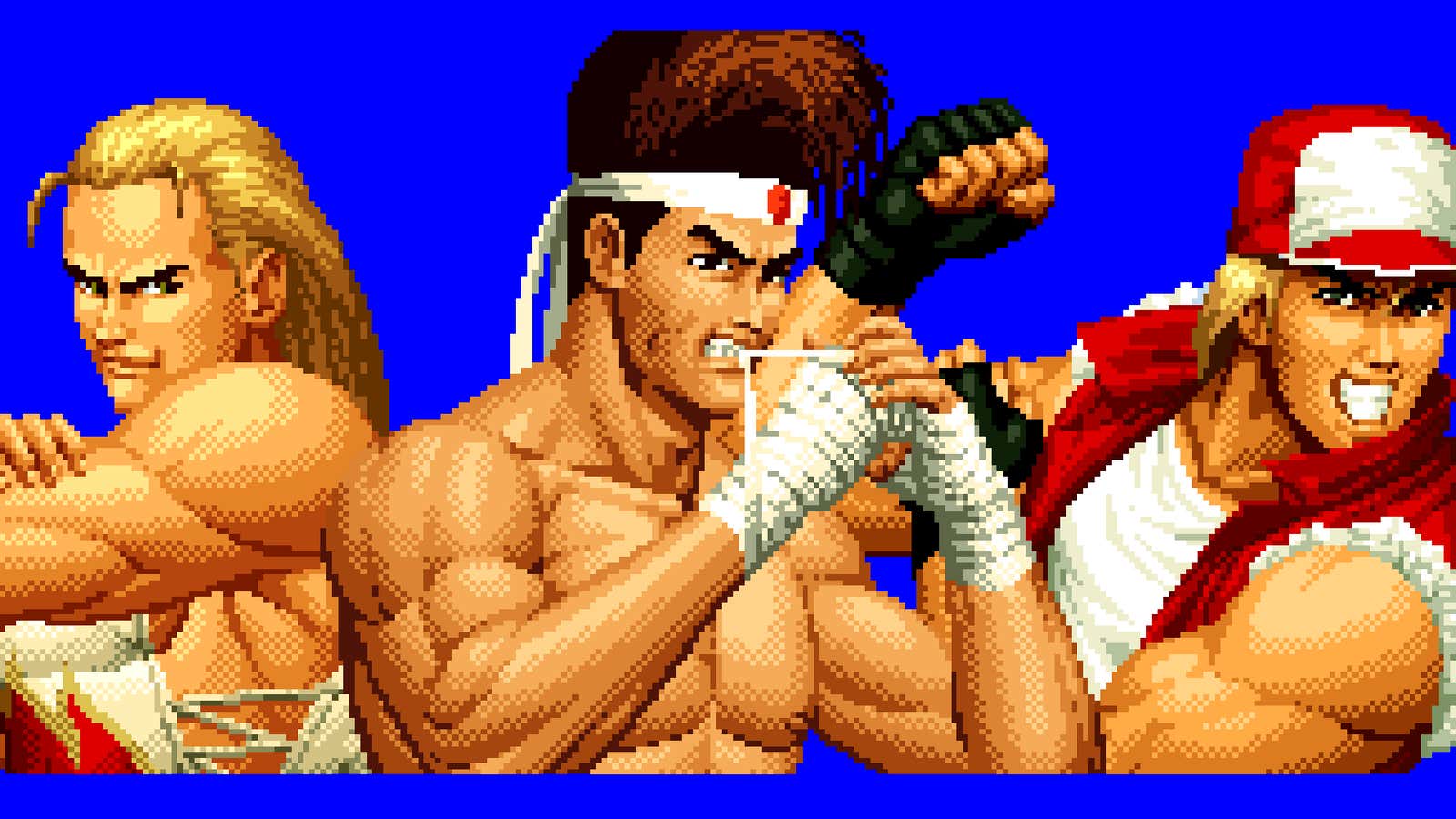What’s the fighting game you remember the most from the arcades of your youth? Street Fighter II? Tekken? Mortal Kombat? If you’re from Latin America, there’s an excellent chance that the first game that jumps to mind wasn’t any of those, and the game that defined your formative arcade experience was actually SNK’s The King of Fighters.
“I would play every day after school,” said Jose Ramon Navarrete, who grew up in Jiquilpan, about two hours south of Guadalajara in Mexico. “Sometimes I would skip school to play [King of Fighters].”
Today, at 32, Navarrete is better known as “kofROMANCE,” a professional King of Fighters player who regularly appears at competitions like EVO. He now lives in Las Vegas, where EVO is held, and often hosts players from out of the country at his house during competitions. “We had Peru, Chile, Brazil, Colombia, and Mexico represented in the house, so we could share a lot of stories from back in the day,” he said. What binds these players from so many countries together, he said, was King of Fighters.

It’s well understood in the fighting game community that King of Fighters is a particular passion for many players from Mexico and other Latin American countries. Posts on larger fighting game forums like Shoryuken over the years have told many anecdotal accounts of the scene, and speculation as to why the franchise has proliferated in the region. According to the players, tournament organizers, and media personalities who spoke to Kotaku for this story, King Of Fighters has a curious ubiquity that has become part of the cultural identity for Latin American gamers.
Fighting game tournaments for KOF around the United States frequently have Latin American representation. The greater the size of the tournament, the higher likelihood of spotting players who traveled from Mexico, Chile, or Brazil. Fire up online emulation matchmaking software like Fightcade, and the location flags next to the majority of players are from these regions, too.
But why?
Getting to the bottom of fact versus assumed internet wisdom can be challenging, especially for something ingrained in genre circles since the early days of Street Fighter II’s success. Taking to Twitter to find some answers, my mentions and inbox were flooded with responses. Dozens of players and tournament organizers from Mexico, Brazil, Argentina and more wanted to tell their stories. And nearly all of them told me the same things, with only incremental details shifting from one source to the next.
Largely, it boils down to the one thing it always does: money.
Three of Every Two
King of Fighters is a fighting game series that began in 1994 with the very on-the-nose title of King of Fighters ’94. The annualized series was an all-star mashup of characters from SNK’s many different fighting game franchises for its Neo Geo arcade platform, pulling its cast from Fatal Fury, Art of Fighting, and the like. As these earlier SNK franchises had something of a loose story continuity, it was easy for the developer to cobble together thin plot threads for crossover mayhem, as well as yank characters from the company’s pre-Neo Geo 1980s output like Ikari Warriors and Athena to expand the rosters even further. It was Smash Bros. before Smash Bros.
The Neo Geo platform that the games ran on was essentially a cartridge-based console for arcades. While it looked like a standard arcade cabinet, Neo Geo ran its games from cartridges that could be easily swapped out by an arcade owner. This meant that upgrading to the latest, hottest game was simply a matter of spending a few hundred dollars on a new cartridge, not thousands on a new machine. And arcade owners could pass that savings on to the consumers when it came time to put in their 25 cents—or their 50 centavos.
In Latin America in the ‘90s, this meant that Neo Geo was nearly always the better alternative. Moreover, kids were more likely to play games on arcade machines than home consoles. While Nintendo and Sega did have a presence in Latin America during this period, high tariffs on the Super Nintendo and Sega Genesis meant that they were often priced out of the range of the average consumer. Part of the reason for these upcharges was Mexico’s history of black- and gray-market console piracy. Video Games Around the World, published by MIT Press in 2015, discusses how US-Mexico border cities were the primary places in the 1980s where gaming consoles could be obtained, with mostly bootleg merchandise trickling southward.

“The Mexican economy was actually better than it is today, but it wasn’t as easy to get consoles,” said player and tournament organizer NeoPenny, who asked that we not use his real name out of privacy concerns. Game machines were only available in electronics stores serving upper-class consumers in larger cities, he said. SNK provided affordable, accessible entertainment to those even in the most rural areas.
By the dawn of the 1990s, arcades became the de facto method of consuming video games in those areas. And so Neo Geo arcade cabinets proliferated in Latin America, King Of Fighters along with it. From arcades in metropolitan hubs to small local drug stores, the Neo Geo was a common fixture on many street corners.
“In Mexico in the late ‘90s and early ‘00s, three of every two drug stores had a KOF arcade,” said Jose Saucedo, a former games journalist and social media manager. “And that’s not a grammar mistake.”
SNK knew this audience existed, and embraced it. It would show off new entries into the series were at yearly events in Mexico City. Photographic evidence of these events show lines for entry stretched around city blocks, full of fans eager to see and test next year’s game.
Starting in the early 2000s, SNK also began including Mexican characters in the games. One-eyed luchador Ramon appeared in King Of Fighters 2000, the lithe Angel arrived in 2001, and pro wrestler Tizoc arrived in 2003. Angel is particularly significant, as her addition is believed by some to be the result of a bet in which the KOF development team in Osaka lost to Rage of the Dragons developer and Mexican game designer Angel Torres in private matches, according to archived interviews with Torres found online. (SNK was contacted for this story but has not responded.)

Another factor led to the continued proliferation of the Neo Geo and its games: Piracy. While Neo Geo game ROMs could be easily dumped into bootleg cartridges that could be sold more cheaply than even the already-inexpensive official games. “The SNK hardware was cheap,” said Saucedo, “easy to dump and copy, allowing almost anyone with a running arcade system to get a KOF ROM. This allowed the game to have a presence in almost every small business in Mexico.”
This gave game centers and arcades in the region an extra shot in the arm. But as the ‘90s drew to a close, arcades in Latin America began to dry up just as they did in the United States. Eventually, bootlegged ROM hacks that altered the once pure KOF experience became more commonplace than legitimate editions of hallowed entries like ‘97 or 2002, leaving past players with bad tastes in their mouths.
This shows us why the Neo Geo platform was so popular in Latin America. But why the King of Fighters series, specifically?
La Reta
SNK’s early Neo Geo fighting games allowed for two-player competition, but much like the original Street Fighter II, they were first and foremost designed as single-player games. As was often the case in the primal years of fighting games, character balance and accurate combo systems weren’t high-priority features, if they were even factored into development.
“Most of the time,” said player Armando Neri, 35, via email, “they were played vs. CPU. It was kind of weird, but it was like they were good one-player fighting games. The only exception would probably be Samurai Shodown.”
It was King of Fighters that changed things. Players chose not one character, but a team of three. This meant that the roster needed to be extensive. In the first game, the teams of three were pre-determined, but starting from the next one players created their own custom teams. This gave competitive players agency in forming groups that matched certain playstyles or unique team synergy. By 1994, combo systems in two-dimensional fighting games were also reaching a certain commonality, so matches wouldn’t result in elaborate slap fights or projectiles thrown haphazardly. KOF games were also made to be played fast, with runs and dashes complimenting short hops and high jumps. In short, KOF was fashioned as a competitive franchise from the start, and with each successive entry in the series, deeper and more complex systems were implemented to keep that competition fresh from year to year.
“You had to bring your best or wait to your next chance if you lose. That helped [you] get better for sure,” said Jose Ramon Navarrete.

“The Mexican term la reta, or ‘the dare,’ means the fact that you’re ready to fight anyone and prove you were the best,” said Saucedo. One of the main appeals of arcades was not just the lower barrier of entry, but the chance to play against human opponents.
When I first started fact-finding for this story, many players and tournament organizers pointed me in the direction of Jean-Carlo Trevino. Trevino, 29, lives in Monterrey, Nuevo León, about three hours south of Laredo, Texas. There, the KOF scene is expansive and active, with players coming in as recently as KOF XIV in 2016 and as old-timey as the late ‘90s heyday of ’95, ’97, and ’98 (the games often cited among the best in franchise history). In addition to answering my questions, Trevino started putting me in touch with other older players and translated some answers for me.
One of the players to whom he connected me was Neri, who also mentioned la reta. “KOF ‘94 became the… game for the ‘retas’ with their innovative 3v3 battle mode,” he said. Being able to pick three characters for just one credit gave it the allure of more bang for your buck. “The developer gave you the option that for one credit, you could choose up to three characters. You enjoyed it for less money.”
For Eduardo “Lalo” Manrique, 34, the drive to win went deeper. “When I was a teenager, I was arriving from school to the corner arcade near my home,” he said. “I beat a kid, but was told there was a better player than me. That day, he was there and he beat me while the kid laughed in the corner.”
The whole affair sparked a lasting friendship. “To this day,” he said, “we meet every Saturday at my home.”
Amongst all the players I talked to, a single phrase came up time and again: “KOF binds us.” The accessible, low-cost hardware made fans. The competition forged communities.
Another player, Jesus Madrid, 32, however, reminded me of another advantage that King of Fighters had over just about every other franchise: consistency. Comparing the franchise to its number one competitor, he told me over email that KOF is different from Street Fighter, and therefore more attractive to players in his region, in “every way,” mentioning the types of characters, the different mechanics, and most importantly, “frequency of new games.”
Capcom released frequent updates to Street Fighter II, but King of Fighters’ annualized release schedule—and the fact that arcade operators could easily swap in the new cartridge—made it a much more vibrant, constantly-changing game. SNK pumped out yearly editions on the Neo Geo until 2003.
Advice
This year, Navarrete studiously trained for EVO, even though a KOF game wasn’t on the main card with the likes of Street Fighter V and Super Smash Bros. Ultimate. Instead, he played SNK’s new Samurai Shodown reboot, tying for 17th place. He also helped run side tournaments for past KOF entries, mainly 2016’s KOFXIV. EVO is as much a convention as it is a tournament, after all, and there are games to play and people to bond with outside of the main competition.
But this year, perhaps more than any other, it wasn’t easy for players outside America to get to Vegas. Complicated politics are fast becoming an issue with not only EVO, but any other event north of the border. “Immigration problems,” said Navarrete, “is and has been issue number one for sure.”
In an uneasy era of wall-building isolationism, current U.S. foreign policies toward its immediate neighbors certainly make for an intimidating trip north. While the current presidential administration focuses in on immigration and asylum as key concerns for easy fear-mongering, programs like rampant detention centers splitting families are enough to make traveling players wary about the opportunity to compete anywhere outside of their home country. The added difficulty of obtaining even visiting visas doesn’t help.
“There are amazing players in the region that have not been able to ever attend a big KOF event in the States due to the difficulties in acquiring the tourist visa required,” Navarrete said. “Toshi (Alberto Toshiro Higa), a legendary KOF player from Peru, had to compete in international events such as the official KOFXIV world championship that was held in Japan, for example.”
This effectively partitions off some of the best competitors in the genre. Tournaments lose many of the main draws who could bring in better competition, or eyeballs for their streams. From the player side, not attending an EVO or other large American tournament like Combo Breaker in Chicago or Community Effort Orlando means missing out on large payouts, as well as any side-tournament money matches. When players get cut off from the biggest tournament opportunities in the world, it’s that much harder to survive as a pro player.
Nearly none of the players I spoke to for this story wanted to talk about the possibility of going to this year’s EVO and being held at the border. Understandable, really. As I write this, ICE agents in Mississippi are gathering undocumented immigrants to deport them en masse, further fracturing families as they have done in mass raids over the past few weeks. The results have been about what you expect. I asked these questions multiple times to several players with only minimal responses.
Saucedo, who is not a competitive player but certainly has knowledge of the situation, offered some clarity.
“Most of the competitors and spectators that go to EVO usually have a valid visa to visit the United States,” he said. But there’s a cost. “Most of the Mexican U.S. visitors received advice about any kind of contact with the law regarding immigration and their legal status in the country.”
That “advice,” he said, comes from two sources—from friends and family members with firsthand experience with traveling to the U.S. and dealing with recent immigration trouble, but also from government-sponsored announcements over Mexican radio that remind travelers of their rights and options if they’re detained by police. “In any case,” he says, “immigration was not as unwelcome in Las Vegas... than in Los Angeles or Arizona.”
It’s not that Latin American fighting game fans only play King of Fighters, but it clearly has an outsized prominence in the history of the genre compared to anywhere else in the world. The confluence of the accessibility of ubiquitous Neo Geo cabinets, easily and rampantly pirated software, and players eager for competitive gaming ingrained it as a piece of cultural identity.
“Everyone seems to know it, play it, and the culture has evolved around it in the gaming community,” said Saucedo. “The first cover of the first non-indie magazine I directed was KOF, just because I knew that it would be the selling point, even when Kingdom Hearts was the most important release of that year.”
Some quotes in this story were lightly edited for clarity.
John Learned is a freelance writer published on spots like USGamer, Paste, The Escapist, and creates Annotated Games on YouTube.
